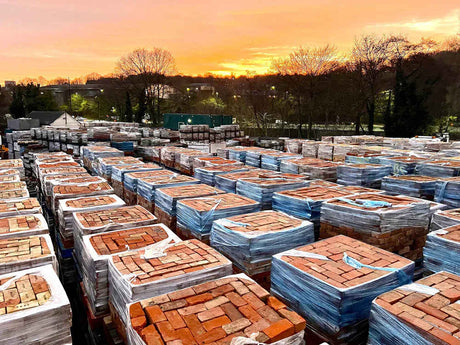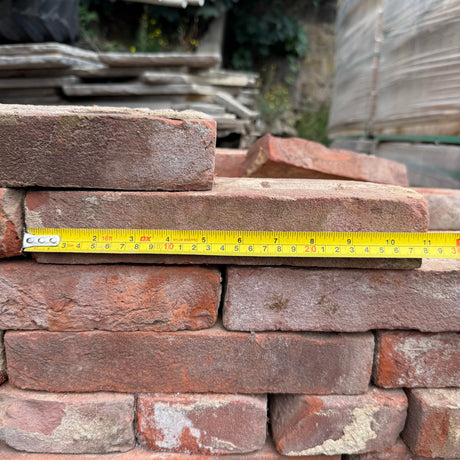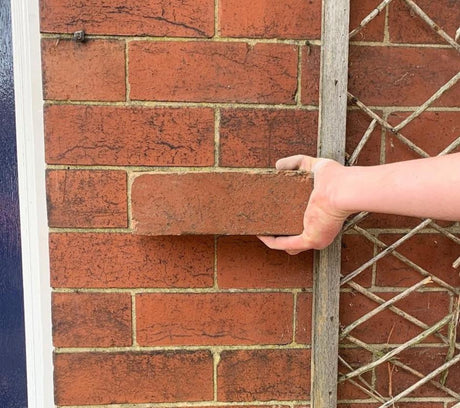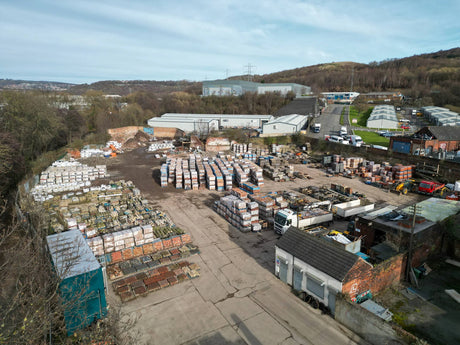What Bricks Should You Use For Your Project?
Building a house is one of the most significant investments you will make in your lifetime, and it's crucial to get every detail right, including the type of bricks you use. Bricks are an essential component of any construction project as they provide strength, durability, and aesthetic appeal. With so many brick types available today, choosing the right one can be overwhelming. In this blog post, we will explore different types of bricks such as Burnt Clay Bricks, Concrete Bricks, Sand Lime Bricks, and Engineering Bricks. Additionally, we will also delve into reclaimed bricks and their benefits. We'll discuss practical tips like selecting the right brick pattern for your build and choosing the right mortar. Lastly, we'll talk about how the type of brick you choose can affect the cost of your build. Read on to learn everything you need to know about selecting the perfect bricks for your project.

Exploring Different Types of Bricks
When selecting bricks for your project, it's essential to consider the different types available.
-
BURNT CLAY BRICKS - Burnt clay bricks, a traditional choice, offer timeless appeal.
-
CONCRETE BRICKS - Concrete bricks, known for durability and low water absorption, provide reliability.
-
SAND LIME BRICKS - If you're looking for a modern, moisture-resistant alternative, sand lime bricks are an excellent option.
-
ENGINEERING BRICKS - For projects requiring higher compression strength and low porosity, engineering bricks are ideal.
- RECLAIMED BRICKS - Lastly, reclaimed bricks offer a unique, authentic look with noticeable flaws, adding character to any build. Consider these variations to find the best match for your project.
Burnt Clay Bricks: A Traditional Choice
When building with burnt clay bricks, it's essential to consider their durability, strength, and authentic appearance. These bricks come in various types, including handmade bricks and soft mud bricks, showcasing the versatility of modular clay products. They are laid using stretcher bond or flemish bond with bedding mortar. Burnt clay bricks are the original building material, often seen in conservation areas, and are made by wetting clay and shaping it into individual moulds before burning. This traditional choice offers a timeless appeal for diverse construction projects.
The Versatility of Concrete Bricks
Concrete bricks, crafted from solid concrete, offer versatility in construction. With various colours available, these durable bricks exhibit low water absorption and higher compression strength. Commonly used for internal brickwork and masonry, wirecut and kiln-fired concrete bricks are well-suited for renovation projects, presenting options in colour, mortar, and materials. Their adaptability caters to diverse construction needs, making them a popular choice among builders and architects. The individual moulds allow for innovative designs and dimensions, contributing to the appeal of concrete bricks as modular clay products.
Sand Lime Bricks: A Modern Alternative
Sand lime bricks, a contemporary choice, are composed of sand, lime, and water, offering excellent place conservation. With noticeable flaws, low porosity, and high compression strength, these bricks promise durability and moisture resistance while providing an authentic appearance. Kiln-fired to ensure low water absorption, they can be obtained from various manufacturers, moulds, and mortar joints, making them a versatile option for construction projects. The individual moulds and main image flexibility of sand lime bricks provide a modern alternative to traditional modular clay products.
The Durability of Engineering Bricks
Engineered with lower water absorption, engineering bricks offer higher compression strength due to their clay composition, making them ideal for various construction needs. Commonly utilized in the south-east of England and London, these bricks are available in different colours, sizes, and mortar options, providing versatility in brickwork. Renowned for their robustness, engineering bricks are particularly suitable for below-ground applications, offering longevity and structural integrity. With individual moulds and wet clay manufacturing, engineering bricks reflect the innovation and durability of modular clay products.

A Special Focus on Reclaimed Bricks
Reclaimed bricks provide a sustainable and cost-effective building material, sourced from reclamation yards for an authentic look. They add character and originality to projects, making them ideal for creating weathered brick walls. Bulk orders should be considered, with sales teams providing valuable consultation. This type of brick offers a unique appeal and can be a key focal point for your build. Utilizing reclaimed bricks can bring a sense of history and sustainability to your construction projects.
The Benefits of Using Reclaimed Bricks
Using reclaimed bricks contributes to sustainable building practices, adding a unique charm and vintage look to your project. These bricks are ideal for conservation areas and creating original, weathered brick walls. With various types available, such as yellow and handmade bricks, they offer versatility for different design needs. Moreover, reclaimed bricks promote environmental responsibility by reusing materials, aligning with modern construction's focus on sustainability and eco-friendliness. By incorporating reclaimed bricks, you not only achieve an authentic appearance but also support the ethos of sustainable development.
Where to Find and How to Choose Quality Reclaimed Bricks
Quality reclaimed bricks are commonly available at reclamation yards and brick libraries, ensuring a unique and authentic look for your project. It's essential to inspect the bricks for noticeable flaws, guaranteeing their authenticity and character. When selecting reclaimed bricks, consider factors such as colour, type, and size, ensuring they align with your project's requirements. Collaborate with your sales team to identify the most suitable brick type for your specific needs. Thoroughly examine the bricks to ensure they are free from any damages or imperfections.

Considerations When Selecting Bricks for Your Project
Matching brick types to specific project requirements is crucial for a successful build. It's important to select the right type of brick, whether it's handmade bricks or clay bricks, based on the project's needs. The chemical reaction of mortar should also be considered when choosing the brick type. Opt for bricks with low water absorption and higher compression strength to ensure durability. Seeking advice from brick manufacturers can provide valuable insights for selecting the most suitable bricks for your project.
Matching Brick Types to Your Project Needs
Selecting the appropriate brick type is crucial for the success of your project. Consider factors such as clay, lime, or concrete bricks that best suit your needs. Ensure that the chosen bricks complement the style and era of your building, align with your project's vision, and reflect the desired colour, texture, and style. Additionally, the type of clay used profoundly impacts the colour and texture of the bricks. Therefore, make your selection wisely to lay a strong foundation for your project.
Brick Colour Selection: More Than Just Aesthetics
When selecting bricks for your project, it's important to understand that brick colour goes beyond aesthetics. The colour influences the building's energy efficiency and overall ambiance, making it a crucial decision. Manufacturers offer a wide range of brick colours to choose from, allowing you to find the perfect match for your project. Consider the architectural style, location, and landscaping to ensure the selected brick colour complements the surroundings. Additionally, opt for brick colours that enhance the curb appeal and value of your property, aligning with the professional tone of your project.
Understanding Standard Brick Sizes and Their Implications
Understanding the standard sizes of bricks is fundamental to the layout, dimensions, and structural integrity of any building. It is important to familiarize yourself with modular, utility, and engineer brick sizes for accurate material estimation and project planning. Additionally, considering brick dimensions in relation to mortar joints is crucial for a seamless construction process. Ultimately, the choice of brick sizes should align with the design, functionality, and budget requirements of your construction project.

Practical Tips: Building with Bricks
When building with bricks, it's essential to ensure high-quality, durable bricks suitable for your project. Properly preparing and dampening the bricks before construction can prevent moisture absorption issues. Utilizing appropriate mortar types and application techniques is crucial for strong, long-lasting brickwork. Adhering to recommended bricklaying standards, including bond patterns and joint thickness, is vital. Don't hesitate to consult with brick suppliers or professionals for guidance on brick selection and installation. Remember, the right bricks and techniques are fundamental to a successful and lasting build.
Selecting the Right Brick Pattern for Your Build
When choosing a brick pattern for your build, it's important to explore different brick bond options, including stretcher bond, flemish bond, and english bond, to achieve varied visual effects. The selected pattern should align with the project's architectural style and structural requirements while considering aesthetic appeal, stability, and maintenance. Discussing brick pattern options with your project team is crucial for a cohesive design vision, and experimenting with different brick bond configurations can result in a unique and visually appealing finish.
Importance of Choosing the Right Mortar
Selecting the appropriate mortar type is crucial for ensuring strong bonding and weather resistance. When choosing the right mortar, consider factors such as mortar colour, strength, and composition to contribute to the structural integrity and longevity of brick masonry. It's essential to consult with masonry experts to determine the ideal mortar mix for your specific building application. Additionally, proper mortar joint preparation and application techniques are imperative for durable and robust brickwork. The right choice of bedding mortar will enhance the overall performance and longevity of the brick construction.
Does the Type of Brick Affect the Cost of Your Build?
The cost of your build can be impacted by the type of brick you choose. Factors like material expenses, labour, and maintenance can vary depending on the brick porosity, compression strength, and production method. Consider the long-term value and performance of different brick types to evaluate their cost implications. Custom or specialty bricks may incur higher costs due to unique characteristics and manufacturing processes. Assess the cost-effectiveness of brick types based on durability, aesthetics, and maintenance requirements.
Frequently Asked Questions
How many bricks do I need for my project?
To determine the number of bricks needed for your project, calculate the total area to be covered and multiply it by the bricks needed per square foot. It's always wise to buy slightly more bricks to account for breakages or mistakes. For an accurate estimate, consult a professional or use online calculators.
Which type of bricks are best for construction?
When it comes to construction, different types of bricks serve different purposes. Clay bricks are commonly used due to their versatility. Concrete bricks offer a more affordable option. Firebricks are designed for high temperatures, while engineering bricks provide superior strength and durability for heavy-duty projects.
How do I choose the right brick?
Consider your building project's purpose, architectural style, and colour scheme when choosing a brick. Look for high compressive strength for added durability. Consult professionals for recommendations on the best brick for your needs.
What Colour Brick Should I Choose?
When deciding on the colour of bricks for your project, consider the overall aesthetic you want to achieve. Neutral shades like beige, grey, and tan are versatile options that can complement various styles. Red bricks add warmth and character, while white bricks create a modern and sleek look. Look at the surrounding environment for inspiration when selecting the right brick colour.
Do I need fire bricks for a fireplace or braai?
Fire bricks are crucial for a safe and functional fireplace or braai. These specialised bricks can withstand high temperatures without cracking or crumbling, unlike regular bricks. Using the wrong type of brick in your fireplace or braai can lead to dangerous situations. Consult a professional for guidance on the appropriate fire bricks needed for your project.
Conclusion
In conclusion, selecting the right type of brick for your build is crucial for both aesthetic appeal and structural integrity. Each type of brick has its own advantages and considerations, from the traditional burnt clay bricks to the modern sand lime bricks. Additionally, reclaimed bricks offer unique benefits in terms of sustainability and character. When choosing bricks, it's important to match them to your project needs, consider the colour and size, and select the appropriate brick pattern and mortar. Lastly, keep in mind that the type of brick you choose can affect the overall cost of your build. By carefully considering these factors, you can ensure a successful and visually pleasing construction project.








